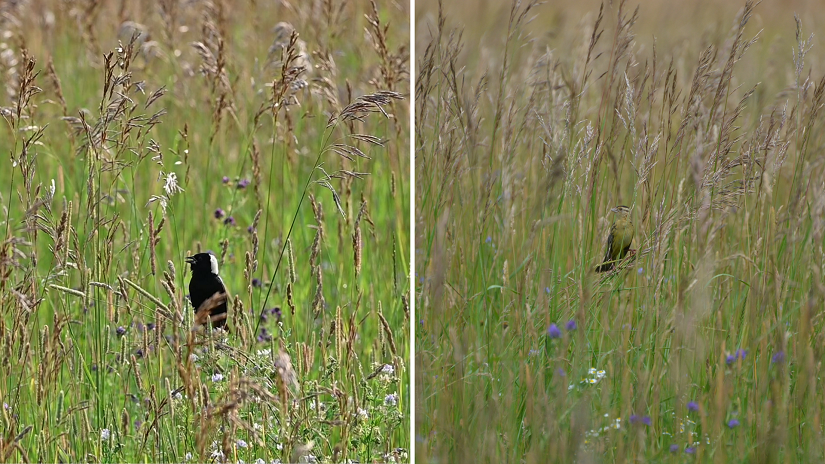Today’s post comes from Victoria Reimer, Bronte Creek Provincial Park’s Green Jobs summer student and friend to birds everywhere.
If you asked me what a Green Jobs student was before I started, I wouldn’t have known myself.
Now, after being in the role, I can tell you it’s a wonderful opportunity to become intimately connected to your park. Every day, my job challenges me, but it also gives me so many opportunities to learn.

A typical day includes lots of walking, iNaturalist data uploading, invasive species management, and speaking with park visitors, but there is one very special type of visitor I spend most of my day with.
These visitors aren’t here to camp, or picnic, or meet our farm animals. You won’t find them hiking the trails or fishing in the creek either!
If you look up above a field of long grass, you just might see their flying acrobatics or hear their bold song. These are Bobolinks, and they’ve become one of my nature mentors!
Meet the Bobolink
Bobolinks (or “Bobs,” as we affectionately call them at Bronte Creek) are beautiful birds, but they are in decline.
These birds are ground nesters. They breed in the swaying grasses of tall-grass prairies and agricultural fields. Due to a number of challenges, including a shortage of their favoured breeding habitat, this species is now listed as threatened.

Located in the ever-expanding Greater Toronto Area, Bronte Creek protects the habitat that the Bobs so desperately need.
It’s up to park staff to make sure the fields they use for nesting and foraging are as welcoming for them as possible. My job is to monitor the Bobolinks to understand how many of them are using these fields and in what ways.
This is incredibly important as it allows us to track the progress of the Bobolinks’ breeding season, so that staff don’t disturb the fields before the birds are done using them.
This is how I have found myself trekking through the Bobolinks’ fields every morning, observing and learning.
Singing for all to hear
I usually hear the males’ clear territorial calls before I even arrive at their fields.
Their call is dynamic, and there’s an almost digital quality to the tones. It sounds more like a ringtone than something from nature.
Their calls can be heard loudly and frequently throughout May to early June, when they are establishing territories and trying to attract females.
Their boldness reminds me to be bold myself, and to enjoy the adventures that can be found in nature.
When the males are the loudest, the females are quiet and secretive.
I usually see fewer of them in the fields, and when they do pop into view, it’s usually just for a short flight before disappearing again into the lush, green carpet of grass. “Why are they so elusive?” I ask myself.
Then I realize it’s because they have important work to do. Each female must build a nest and lay her eggs in a well-camouflaged spot, so that predators won’t find them. In this way, the females’ apparent absence from the field actually taught me a lesson about their world.
It reminded me to be still, remain patient, and look below the surface to take in the less obvious joys of nature.
Taking flight
Sometimes, though, finding the best gems in nature boils down to plain luck.
Luck is what I had on the day when, walking through one of the fields, I scared a female Bobolink out of the grass. Her flight was so sudden that it scared me as much as her!

At the spot where she’d taken flight, I found something that made the whole ordeal worth it: a Bobolink nest.
Bobs are so good at hiding their nests that it’s rare to actually see one, so finding one so unexpectedly filled me with a rush of glee.
Finding that nest reminded me of why I’ll always keep coming back to nature.
Sometimes being outdoors is too hot, or wet, or buggy. It’s worth it to brave these conditions, though, because if you spend enough time out in nature, you are bound to encounter some amazing things.
You never know when you’ll find a Bobolink nest — or a spectacular insect, or a funny frog, or the sweetest flower you’ve ever smelled!
Moving forward
Soon the Bobolinks will reach the end of their breeding season at Bronte Creek.
They’ll leave the fields, and I won’t get to see them every day. It’s sad to think about them leaving, but it comforts me to know that our park has hosted them as they raised a new generation.

I’m proud to say that I helped protect the park’s Bobolinks, so others will have the chance to learn their own lessons from these birds, and the nature that supports them.
Ontario Parks is supporting the third Ontario Breeding Bird Atlas: an enormous community science initiative that aims to survey all the province’s breeding birds.
It’s a big job, so if you like birds and care about their conservation, we could use your help!
